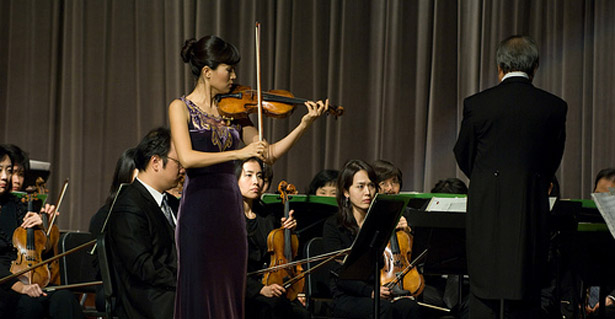The Peninsula
A Discordant Symphony for Track II Diplomacy with North Korea

By Sarah K. Yun
Immediately after the Leap Day Agreement between the U.S. and North Korea, people-to-people exchanges increased significantly with the Track II dialogues in New York and the North Korean orchestra Unhasu’s performance in Paris. However, North Korea recently announced its plan to launch a “satellite” which threatens future of the nutritional assistance and the nuclear/missile moratorium. What is the significance of Track II and people-to-people exchanges in light of the potential breakdown in diplomacy?
Only a couple of weeks after the agreement, Ri Yong-ho, North Korea’s Vice Foreign Minister and chief envoy to Six-Party Talks, was in New York to attend Track II dialogues. Several Track II dialogues were organized by Syracuse University, Friedrich-Ebert-Stiftung, and National Committee on American Foreign Policy, and attended by representatives from the U.S., South Korea, North Korea, China, the EU, Japan, Mongolia, Russia and the UN with diverse backgrounds in academia, government, think tanks, civil society, and more.
On Wednesday, March 14, the premier North Korean orchestra named Unhasu teamed up with Radio France Philharmonic under the leadership of a worldly renowned South Korean conductor Chung Myung-whun, principal conductor of Seoul Philharmonic Orchestra and musical director of Radio France Philharmonic. This was the first time for a North Korean orchestra to visit Europe. Radio France released a statement saying that “music can be a key that opens the path to dialogue and brings down barriers earlier considered insurmountable.”
The relationship between the U.S. and North Korea appeared to be on the road for cautious improvement until the recent announcement of the satellite launch. Now, North Korea’s actions may have undermined both its relationship with Washington and the Track II dialogues.
Why Track II and Music Diplomacy?
Track II dialogues and music diplomacy have not been a new phenomenon. They have made sporadic appearances in diplomacy with North Korea, such as the one organized by the National Committee on American Foreign Policy in 2005 and Georgia University in 2011. In April 2011, a North Korean delegation reportedly visited the U.S. to tour American companies such as Google, Home Depot, Bloomberg, Citigroup, Qualcomm and more, to show the potential economic growth North Korea can experience under denuclearization. On February 26, 2008, the New York Philharmonic Orchestra performed in Pyongyang for the first time despite concerns that it was a propaganda coup for North Korea. In 2000 and 2002, the inter-Korean symphony concert performed in Seoul and Pyongyang respectively. Music diplomacy has been employed throughout the history of the Cold War. In 1956, Boston Symphony Orchestra became the first prominent American ensemble to perform in the Soviet Union, followed by the New York Philharmonic Orchestra in 1959. In 1973, Philadelphia Orchestra performed in Beijing, following Nixon’s visit to China in 1972.
According to Joseph Montville, Track II dialogue is an unofficial, informal interaction between members of adversarial groups or nations that aim to develop strategies, influence public opinion, and organize human and material resources in ways that might help resolve their conflict. It is structured to rid the parties of the constraints of official Track I negotiations and public pressure. The main goals are to build trust among opposing parties and create spillover opportunities for Track I dialogues. Track II and cultural diplomacy can be especially helpful with difficult cases like North Korea where there is the lack of a regular communication channel. In the case of North Korea, people-to-people exchanges create opportunities to relieve pressure and understand policy options and processes through less formal contacts.
What went wrong?
The problem of Track II and people-to-people exchange derives from the clash of objectives between the U.S. and North Korea. For North Korea, the objective of Unhasu’s joint performance and Track II dialogues was to improve North Korea’s international reputation and thereby legitimize the new Kim regime. On the other hand, the objective for the U.S. and France (in this case) was to transfer information to the U.S. government and warm atmosphere for Track I diplomacy. North Korea’s objectives will either be to keep Track II and cultural diplomacy as separate issues from the larger political issues to prevent spillover effect into regime instability or to use them as tools to gain more concessions.
Therefore, the U.S. and the Six-Party Talks nations should strategically coordinate people-to-people exchanges with other political strategies to create spillover effects. Unless exchanges with North Korea are sustainable, systemized and incorporated into the larger policy, it will only become a short-term stand alone North Korean tactic to legitimize its regime or gain other benefits.
Sarah K. Yun is the Director of Public Affairs and Regional Issues for the Korea Economic Institute. The views expressed here are her own.
Photo from Morning Calm News’ photo stream on flickr Creative Commons.
